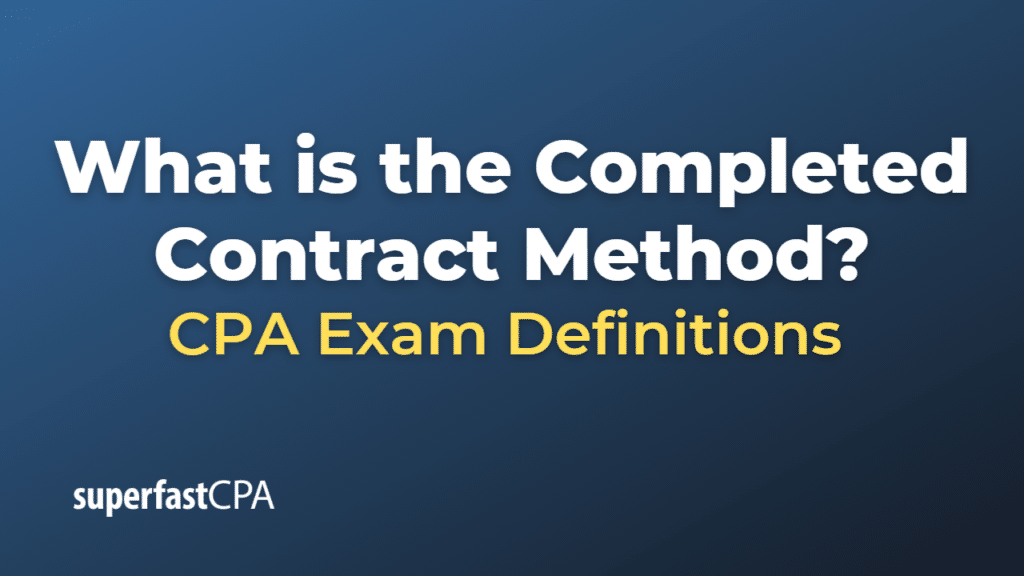Completed Contract Method
The completed contract method (CCM) is an accounting approach used to recognize revenues, expenses, and profits related to long-term contracts, particularly in industries such as construction, engineering, and large-scale manufacturing. Under the completed contract method, revenues, expenses, and profits associated with a contract are recognized only when the contract is fully completed or substantially completed.
The primary principle behind the completed contract method is to defer revenue and cost recognition until the contract is completed to ensure that the final outcome of the project can be determined with certainty. This method helps minimize the risk of misstating financial results due to changes in estimates or unforeseen circumstances that may occur during the course of the contract.
The completed contract method involves the following steps:
- Accumulation of costs: As the work on the contract progresses, the costs incurred are accumulated on the balance sheet as work-in-process (WIP) or construction-in-progress (CIP) inventory.
- Billings and cash receipts: The company may bill the customer and receive cash payments throughout the contract’s duration based on the contract terms or progress milestones. These cash receipts are recorded as a liability on the balance sheet, under “billings in excess of costs” or “deferred revenue.
- Contract completion: When the contract is completed, the accumulated costs, revenues, and profits are recognized in the income statement. The work-in-process (WIP) or construction-in-progress (CIP) inventory is transferred to the cost of goods sold (COGS), and the billings in excess of costs or deferred revenue are recognized as revenue.
It is important to note that the completed contract method is generally considered less preferable to the percentage-of-completion method (PCM) under the Generally Accepted Accounting Principles (GAAP) and International Financial Reporting Standards (IFRS) when it comes to long-term contract accounting. The percentage-of-completion method recognizes revenues, expenses, and profits as the contract progresses based on the percentage of work completed, providing a more accurate representation of the company’s financial performance over time. However, the completed contract method may still be appropriate in certain circumstances where the outcome of the contract is uncertain or where the percentage-of-completion method cannot be reliably applied.
Example of the Completed Contract Method
Let’s consider a hypothetical example of a construction company, BuildPro, that is engaged in constructing a commercial building for a client under a two-year contract. BuildPro uses the completed contract method to recognize revenues and expenses related to this project.
Here’s an overview of how the completed contract method would be applied:
Year 1:
- BuildPro incurs $2,000,000 in construction costs during the first year. These costs are accumulated on the balance sheet as construction-in-progress (CIP) inventory.
- During the first year, BuildPro bills the client $2,500,000 based on the contract terms or progress milestones. The company records this amount as a liability on the balance sheet under “billings in excess of costs” or “deferred revenue.
- No revenues, expenses, or profits are recognized in the income statement for Year 1 since the contract is not yet complete.
Year 2:
- BuildPro incurs an additional $3,000,000 in construction costs during the second year. The total accumulated construction costs now amount to $5,000,000.
- During the second year, BuildPro bills the client an additional $3,500,000, bringing the total billings to $6,000,000.
- At the end of Year 2, the construction project is completed. BuildPro recognizes the accumulated costs ($5,000,000) as cost of goods sold (COGS) and the billings in excess of costs ($6,000,000) as revenue in the income statement.
- The resulting profit of $1,000,000 ($6,000,000 in revenue minus $5,000,000 in costs) is also recognized in the income statement for Year 2.
Under the completed contract method, BuildPro recognizes the revenues, expenses, and profits related to the construction project only upon its completion. This approach defers the recognition of financial results until the final outcome of the project can be determined with certainty. However, it is essential to note that this method may not accurately reflect the company’s financial performance during the contract’s duration, as it does not recognize any revenues or expenses until the contract is fully completed.













